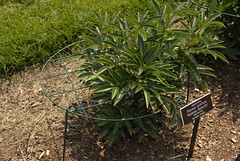Tip of the week — 7/8/07
Posted in Gardening Tips on July 8 2008, by Sonia Uyterhoeven
What’s at Stake?
 Sonia Uyterhoeven is Gardener for Public Education at The New York Botanical Garden.
Sonia Uyterhoeven is Gardener for Public Education at The New York Botanical Garden.

The best advice that I have ever heard about staking plants in the garden is twofold: Stake early before the plants need it, and don’t put your plants in a straight jacket—the idea is to see the plant and not the staking.
The aim then is to hide the stakes in the plant; when using string or twine pass it underneath the foliage and work with the natural structure of the plant. There are many different staking techniques and products available to the gardener.
You can use store-bought products such as peony hoops that fit neatly over the plant and can be raised up as the perennial grows. A plethora of stakes are available in gardening centers and from catalog companies; find the ones that work for you and your perennials.
For some jobs you can take the bounty of your spring pruning and use the branches as stakes. I have done this in the vegetable garden in the Home Gardening Center using leftover butterfly bush (Buddleia) branches to hold up peas and climbing nasturtiums. The key here is to place the twigs close to each other and get them deep enough into the ground so that they can support the plant.
Most of the staking done in this garden is done the old-fashioned way, with bamboo stakes and string. The stake generally needs to support only the bottom half of the perennial; in this way it doesn’t obstruct the view of the flower spike and lets the plant move naturally in the wind.
If the plant can only be viewed from one direction, stake from behind. If the plant can be viewed from all four sides, place the cane in the center of the plant. Drive the cane deeply into the ground to give maximum support. When tying the stems, work the strings beneath the foliage. Make a figure eight around the stem with the string and tie to the stake. If the plant has multiple stems, loop the string around all the main stems and tie to the stake.

